The Great Hollyleaf Redberry Mystery
July 14, 2012 | Updated June 22, 2020
As an Amazon Associate I earn from qualifying purchases.
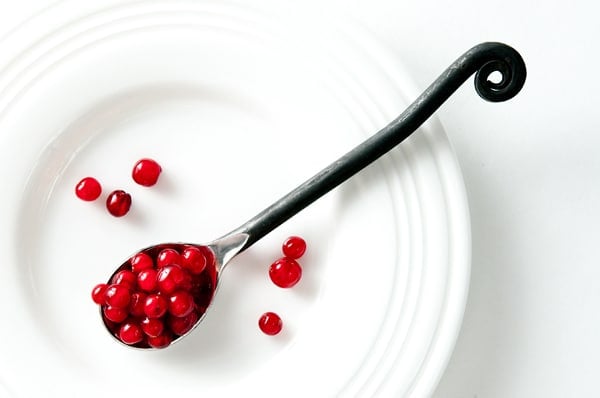
One day I took a walk. On that walk I saw a bush I’d seen before, only this time it had so many scarlet berries on it the plant looked like an overzealous father had decorated it for his neighborhood Christmas contest. I stopped and stared. The berries were so luminous the almost glowed from within.
But they were red, and red berries have a bad habit of being toxic in North America. I left them alone and walked on.
Something in the back of my head started itching. I have an unusually good memory for patterns and photographs, which serves me well as a forager. And I knew, just knew, that I had seen this plant in one of my edible plant books. But I couldn’t place it mentally. I walked back to the bush and looked at it again, this time with an eye toward remembering its tiny details.
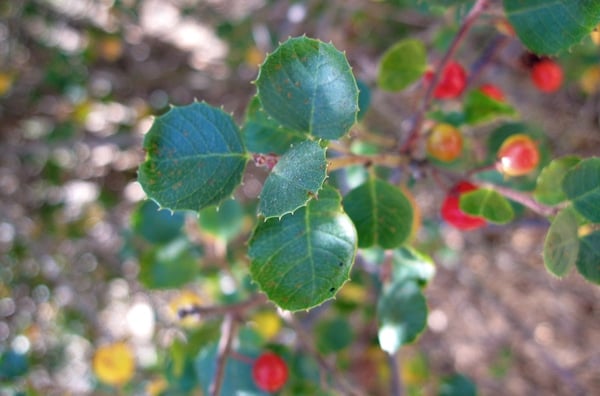
When I got home I opened up my books. Huh. Nothing. Maybe the internet could help. But how to find it? Well, the bush had red berries and little leaves that looked like holly. So I typed in “holly leaf red berry.” And found that the bush is actually called holyleaf redberry. Go figure.
My next searches are always to add the terms “edible” and “toxic” to the plant. And here’s where things get weird. Both came up. What’s more, searches on what appeared to be the plant’s Latin name, Rhamnus ilicifolia, turned up precious little on either the edibility or the toxicity of this plant. Finally I found a reference to it being edible.
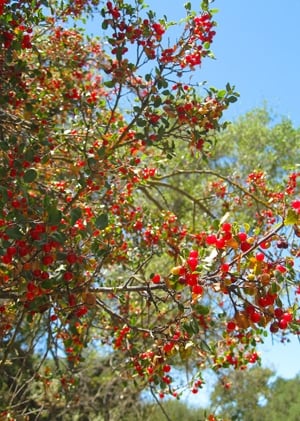
I returned to the bush and picked a berry. I tasted it on the end of my tongue, as I do a lot with unknown berries. If the taste is bitter or unpleasant, the berry will either be unripe or downright toxic. You then spit everything out. This berry was soft, a little sticky and had two large seeds inside. I crushed it against the roof of my mouth and immediately got a hit of sweetness. A good sign. Then a hit of cherry, followed by an aftertaste like cinnamon. A very good sign. Still, I spit out the berry for safety’s sake. But I picked a little jar full to take home, just in case.
Back to the research. One of the things any decent forager does when faced with a new plant is to check with the Indians. If the people who came here first — and were here for 10,000 years before we showed up — never used a plant, you can be pretty damn sure there’s something wrong with it.
Thankfully there are several Native American ethnobotany databases online, including this excellent one from the University of Michigan.
Oddly, a search of R. ilicifolia only turned up evidence that the Indians used the bark to help treat rheumatism. No word on the berries. Huh. Search after search, in places like the Jepson Manual, the USDA database and other places, turned up little or nothing on this plant.
Now I started to get nervous. But I’d been doing the “sweet test” on berries with my tongue for 30-plus years and it had always worked. Could there possibly be a toxic berry that is also sweet? There had to be an explanation.
More searching. Finally, I came across a piece of data noting that R. ilicifolia was not an actual genus-species name, like Homo sapiens. It was shorthand for Rhamnus crocea var. ilicifolia. So ilicifolia is a subspecies name! Off to another database, this one the Integrated Taxonomic Information System.
This is where you go when you want to cut through a confusion of Latin names — and that happens more than you think. Everyone wants to name a new species of something, so you often get competing names for the same plant. The ITIS is the arbiter. And there it was: Not only was R. ilicifolia a subspecies name, it is an “unaccepted” name, too. Apparently the official subspecies name for this plant is R. crocea ssp. pilosa.

That changed everything.
There is a ton of data on Indians eating the berries of R. crocea. All these subspecies came about because the bush can have leaves of a different shape depending on where it is; the one on my walk happened to have holly-like leaves. Some have smoother leaves. But all the berries are edible, although some are better than others.
Why did I bother to tell you all this? Because it is important to not mess around with new plants until you are 100 percent certain they are edible, and if so, how are they edible. Take the yew, for example. The flesh of yew berries is delicious, but the seed inside is highly toxic, and in large doses can even be fatal. I needed to know this sort of information with the hollyleaf redberry before I could experiment with it, and, more importantly, tell all of you about it.
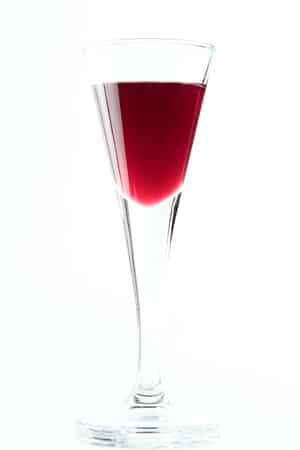
So what did I finally do with my redberries? I did what I do with any seedy berry: I made syrup. How I will use that syrup remains to be seen, but it is a powerful flavor. It’s as if cinnamon and a cherry had a love child, with a little bit of that funky aroma you get with a highbush cranberry. I suspect it will go really well in a pan sauce with wild duck.
If you want to go get some yourself, you’ll have to be in Oregon, California or Arizona. The plant only lives there. If you don’t live in R. crocea’s range, use this post as a model for any new berry you may encounter: There are literally hundreds of edible berries in North America, and no one can know them all.
Hollyleaf Redberry Syrup
Ingredients
- 1 cup sugar
- 1 cup water
- 3 cups hollyleaf redberries
Instructions
- Melt the sugar in the water in a small pot set over medium heat. Once the sugar has melted, add the berries and bring to a simmer. Turn off the heat, crush the berries with a potato masher and cover the pot. Let this steep off the heat for at least 1 hour, and preferably 4-6 hours.
- Set a food mill with the fine plate over a bowl. If you don't have a food mill, use a medium-meshed strainer set over a bowl. Pour the berry mixture through the strainer or food mill and sift out all the seeds. It's your choice whether to let the pulp get into your syrup. I like having some in there. Pour the finished syrup into a glass jar and keep refrigerated.
Nutrition information is automatically calculated, so should only be used as an approximation.
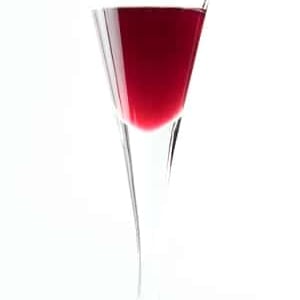
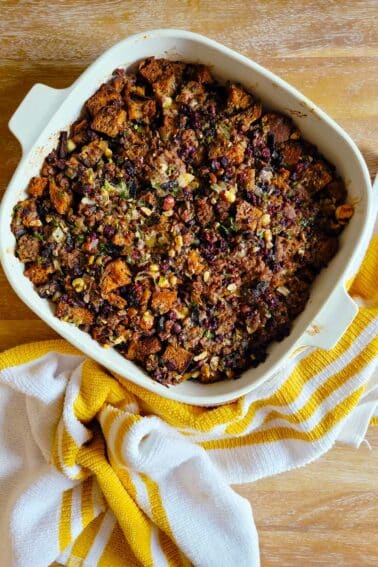
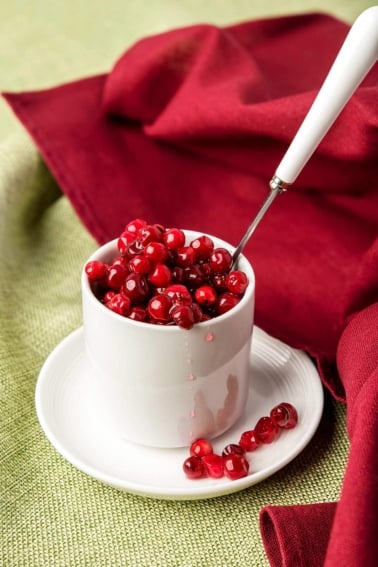
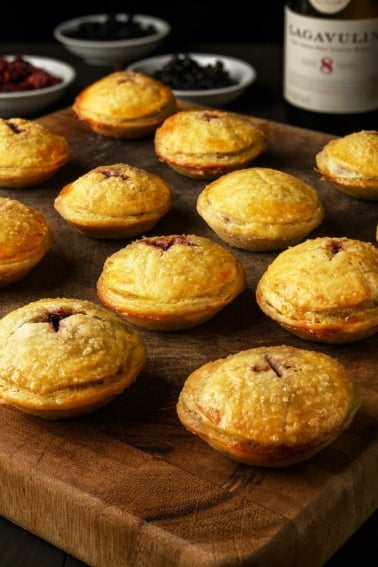

Calflora.org shows that Rhamnus ilicifolia grows all over California, but that Rhamnus pilosa only grows in San Diego county. I tasted what I believe to be hollyleaf redberry (Rhamnus ilicifolia) several times on several hikes in Los Angeles county, and each time the taste was bitter and others have confirmed my assessment. I think that I’ll refrain from eating these berries for now.
I had a similar experience as you, regarding the redberry … I have lived on this very rural property for 30 years, and have gone up and down my road upteen times a year and had never seen this little bush with fruit. It is not big, and is growing in the midst of a young oak, but a branch of it leans out. It happens to be on the driver’s side as I head home, and I always go very slowly, watching for wildlife and flowers. And there it was — bright red and window high. I stopped, got out and took a close look. I wanted to badly to taste one of those shiny little almost glowing red fruits, but I knew I had to ID it first. Thank you for confirming my researched ID. I shall go home and try one (if the birds have left me any). I stumbled onto your site, and I shall come again. Ms B
Do you think these could be processed through a steam juicer?
Billie: I don’t know, sorry.
Also encountered the plant/berry on a walk and was researching. Was going down the same path and fortunately found your article. Not only did I find the info I wanted, I learned of the resources for future better researching. Thank you!
I enjoyed your commentary and your diligence in finding the real plant id. I saw these on my walk today in the San Diego area 6/26/22, so they matched your July harvest (dry year things are happening earlier than normal). Tons of berries this year.
It’s hard to tell from the pics but it looks and sounds like what you’ve got is red currants. They are similar in size, shape, and red color to holly berries except that red currants are fairly translucent. You can see through it to the few white seeds suspended in the middle. To me they taste similar to raspberries only a little more tart. They are my favorite but difficult to find so I grow them myself.
Dionne: They are not red currants.
I have hollyleaf redberry on my property. Definitely not currants. I let the birds have mine, especially now that it’s so hot out. They need it more than I do.
I found your post trying to figure out if a shrub on my nature trail is the same edible berry. Any thoughts? https://sites.google.com/view/hinklecreekpostguide/post-12?authuser=0
Dear Hank,
As you mentioned above, I was having a very hard time trying to clearly identify these little jewels. Such beauties these berries are. A ton of work and not much to them, but worthy none the less. I was reading on another website, (https://granadanativegarden.org/page/3/) where they call a berry a, Holly Leafed Cherry, do you think they are talking about the same berry/plant? At the moment I am up to my ears in Elderberries, so finding the time to manage all these treats is a struggle.
thanks for your wonderful posts! I always find them amusing as you use many phases I would use!
Mari,
Holly-Leafed Cherry is a completely different plant, Prunus ilicifolia ssp. ilicifolia. These are a true cherry though evergreen, and the pit to fruit ratio is much greater than in commercial varieties. The cherries when ripe are dark purple to black, and they are edible and tasty, though the large pits mean you get very little fruit. All that being said, there is very little chance you would mistake this plant with the much smaller Rhamnus ilicifolia being discussed in this article.
Thank you so much. This is a banner year for this berry on the west side of the Mazatzal Mountains. I would have consumed a (old lady size) ton of them this weekend if I had had this info. So glad to know this for future fall backpacks.
I just found some of these near Los Olivos and I knew I had seen them before. Turns out I had read your post previously. I used Seek to find the name but I am still always cautious until I get full confirmation. I think I will go harvest some of these and some fennel pollen this week.
After further investigation, I’ve concluded the bush we have near our cabin is Fremont Barberry (Berberis fremontii). I wish I would have picked a bunch before leaving and I won’t be back for a month. Maybe some syrup, or maybe some barberry wine…
We were at out cabin in Northern Arizona (specifcally, north of Ashfork at 5700 feet in juniper-pinion pine forest). What I called a holly bush had ripe blue colored berries. When cut open, they were blood red and sticky. Could this be a relative of the same bush you are describing? The berries were not in bunches like grapes, but on separate stems each.
I’m from florida and I know the fruit as a syrupberry
Saw This plant on a hike above Pasadena, Ca. So bright, it glowed. I looked up this plant in a native American medicinal plant book and it said that eating the berries of this plant and some similar species could do damage to the gut lining over a long period of time. The book was a medicinal book by Cecelia Garcia and John Adams Jr.
KM: I don’t eat them in quantity.
Thank you for this. I researched & started eating Hollyleaf Redberries around 3 years ago. We have several of these wonderful bushes at our ranch in central California. Funny thing I’ve noticed; they only berry every few years, if that. This year is the first year one of ours at the house has berried and we’ve been here 5 years! Down the road are a few that have berried 2 years in a row.
Our berries are not as flavorful as the variety you describe but the plants look identical. I visited our bush a few days ago and brought some berries to the baby crow we’re raising. She wasn’t interested. But I am. I’ll be making a syrup on Friday when I can some tomato sauce & gherkin pickles.
Thanks for the write up. I’ll show my husband, who is extremely nervous about me eating the berries.
You are right, formerly all these hollyleaf redberry species were treated under the species Rhamnus crocea. Today though they are accepted as separate species (R. ilicifolia, R. crocea, R. pilosa). However you have learned something that any good botanist does, which is that if you want to find information in older places, you might have to use an older name to find results!
Yeah, I ate a handful of these berries on a hike in Santa Paula Creek. They wrecked me for days. I puked so violently that half of one of my eyes was blood shot for a full month. For at least an hour I went running off to dry heave away from my family and friends that were enjoying the water. It turns out the seeds are full of arsenic! With this long post about rhamnus redberry and all the comments it’s surprising that everyone sofar has failed to mention this important detail that I so painfully experienced first hand! And they are very sweet and beautiful with their transparent redness. But those seeds are something bitter my friends!
Matt: Interesting, and damn man, I am sorry to hear that! To be honest, I’ve never eaten more than a few raw berries myself — I’ve only made this syrup, which removes the berries. Thanks for posting this as a warning for others!
Thank you.
Just recently noticed the red berries on this bush when we saw it covered with bluebirds enjoying the berries. We just thought it was a scrub oak. (Maybe the berries have always been eaten before we had a chance to notice.) It’s always a wonderful surprise to discover something new here in Tehachapi.
Thankyou somuch for this info the bushes are full of birds and look so much like holly berries and the jagged edges of the leaves .. had no clue as to what they were in late june!
I enjoy the Rhamnus red berries, they cool juicy burst of flavor is a delight during a hike in Southern California.